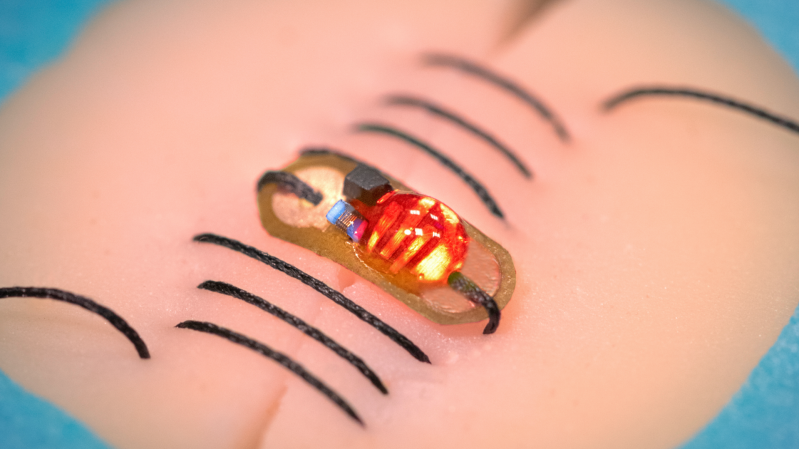A team at the Wireless Bioelectronics Lab at the National University of Singapore led by [Dr John Ho] announced the results of their new Wireless Sensing (WiSe) smart sutures program last month. Their system consists of a specially prepared patch of polymer gel (the sensor) which is sewn into the wound using a silk suture coated with a conductive polymer. An external reader scans the sensor to monitor the status of the wound.
The concept is not unlike a NFC public transportation card, although with simplified electronics. There is no microcontroller or digital data being transferred. Rather, the sensor behaves like a tuned tank. The gel on the sensor was designed to degrade if the wound becomes infected, changing capacitance of the sensor structure and thus shifting its resonant frequency.
If you’ve ever had the misfortune to experience surgery, no doubt the surgeon and nurses drove home the importance of diligent monitoring of the wound for early signs of infection. These smart sutures allow detection of wound infection even before symptoms can seen or felt. They can be used on internal stitches up to 50 mm inside the body. More details can be read in this paper, and we covered another type of smart sensor back in 2016.
















As much as I love electronics, this seems more like a chemistry type problem. The “sutures with beet juice concentrate that change from a bright red hue to a purple color when the pH level indicates an infection” invented by Dasia Taylor seemed like a much better solution that even an idiot can understand. In addition, it would be a more affordable solution as well which is important in medicine if you want to reach the third-world. I’m not saying beet juice concentrate is the way to go but I am saying it certainly seems like it’s on the right path toward a superior solution.
I agree, this simple low tech indicator approach is much better.
Can that simple indicator be read up to 5cm within the body.
That does seem to be an advantage of this method. Also I wonder what types of infection it can notice. An accidental false negative would be bad if people are relying on it without knowing the limitations… Like patients tend to soon the regular.
If your doctor is still using silk sutures you might to try someone else. Silk is a multifilament suture which acts like a wick and increases the risk of infection. Additionally it causes worse scars to form. Finally silk sutures should be removed and not left in which does not make them suitable for internal sutures. Synthetic monofilaments are much better for you. If the surgeon says silk is easier to tie (true) then they need to work on their basic skills.
I looks to be aimed at third world countries.
In modern countries we use internal solubles for deep lacerations with removables at the dermis.
The circular stitch pattern shown in the image isn’t practiced much anymore. It allow too much lateral movement between lateral surfaces of the original laceration and causes more prominent scaring.
Sub-dermal to epidermal “butterfly” stitch pattern is more often used if sutures are used at all.
Early last year a had a lung lobectomy that results in a long and deep incision. It was simply Glued back together.
Ouch and respect for getting through the cardiothoracic surgery, [RÖB].
It’s no fun whatsoever.
Yeah, almost died. A 5 day hospital visit turned into ICU and then 5 weeks and I’m still struggling to breath a year later. Cancer is gone though lol.
Glad to hear that. Missing a lobe is no fun.
“Scars are like tattoos, but with better back stories!”
When the doctor took out my dialysis tubing, I think he crazy glued me back together. I wasdn’t watching, but the final step, he pressed really hard in one tiy spot, and kept looking at the clock. “Does it hurt?” , no, but I wasn’t expecting that.
No stitches were removed.
I’ve been told super glue got its start in wound sealing actually!
I have a fingertip that got glued back on and it works fine. Ever since then I’ve made sure to keep some of super glue around. Usually the medical grade, but I’ll admit that I’ve plopped regular super glue on a wound or two in a pinch… and I haven’t died too horribly just yet.
I’m sure someone will be along momentarily to tell me it causes super-mega-cancer and for everyone else to be less stupid than me. If nothing else though the medical grade is *WAY* easier to apply while injured since it’s roll on and more gel like and is still flexible when dried.